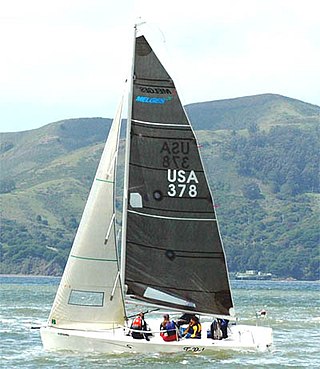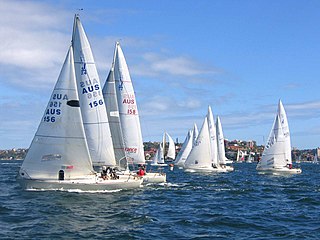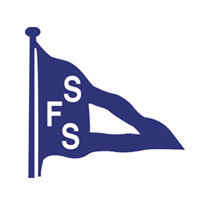
Yachting is recreational boating activities using medium/large-sized boats or small ships collectively called yachts. Yachting is distinguished from other forms of boating mainly by the priority focus on comfort and luxury, the dependence on marinas for docking, and being typically only for exclusive social leisures such as cruising, fishing trip or racing.

Yacht racing is a sailing sport involving sailing yachts and larger sailboats, as distinguished from dinghy racing, which involves open boats. It is composed of multiple yachts, in direct competition, racing around a course marked by buoys or other fixed navigational devices or racing longer distances across open water from point-to-point. It can involve a series of races with buoy racing or multiple legs when point-to-point racing.

Dinghy sailing is the activity of sailing small boats by using five essential controls:

Dinghy racing is a competitive sport using dinghies, which are small boats which may be rowboats, have an outboard motor, or be sailing dinghies. Dinghy racing has affected aspects of the modern sailing dinghy, including hull design, sail materials and sailplan, and techniques such as planing and trapezing.
Boat racing is a sport in which boats, or other types of watercraft, race on water. Boat racing powered by oars is recorded as having occurred in ancient Egypt, and it is likely that people have engaged in races involving boats and other water-borne craft for as long as such watercraft have existed.

Model yachting is the pastime of building and racing model yachts. It has always been customary for ship-builders to make a miniature model of the vessel under construction, which is in every respect a copy of the original on a small scale, whether steamship or sailing ship. There are fine collections to be seen at both general interest museums such as the Victoria and Albert Museum in London and at many specialized maritime museums worldwide. Many of these models are of exquisite workmanship, every rope, pulley or portion of the engine being faithfully reproduced. In the case of sailing yachts, these models were often pitted against each other on small bodies of water, and hence arose the modern pastime. It was soon seen that elaborate fittings and complicated rigging were a detriment to rapid handling, and that, on account of the comparatively stronger winds in which models were sailed, they needed a greater draught. For these reasons modern model yachts, which usually have fin keels, are of about 15% or 20% deeper draught than full-sized vessels, while rigging and fittings have been reduced to absolute simplicity. This applies to models built for racing and not to elaborate copies of steamers and ships, made only for show or for " toy cruising."

The 18 ft Skiff is considered the fastest class of sailing skiffs. The class has a long history beginning with races on Sydney Harbour, Australia in 1892 and later in New Zealand. The boat has changed significantly since the early days, bringing in new technology as it became available. Because of the need of strength, agility and skill, the class is considered to be the top level of small boat sailing. Worldwide this boat is called the "18 Foot Skiff". It is the fastest conventional non-foiling monohull on the yardstick rating, with a score of 675, coming only third after the Tornado and Inter 20.

The Flying Eleven is an Australian boat designed as a high performance racing skiff suitable for 12- to 18-year-olds. High performance sailing is fast becoming the goal of a great many dinghy sailors with the appearance of 49ers as an Olympic class.The Flying Eleven is a logical step in the transition between junior classes such as the Manly Junior or Sabot and prepares young sailors for classes such as Cherubs, 420s, 470s, 29ers, Moths, 13s or even 49ers.

The 12 ft Skiff is a development dinghy class dating back to the early 20th century. It is sailed in Australia and New Zealand. It is 12 ft (3.7 m) in length, hence the name, and is a two-man boat. Both the crew and the helm are able to use the trapeze at the same time. It has an asymmetrical spinnaker and a jib, in addition to the mainsail.

The Nepean Sailing Club (NSC) is a sailing club located on Lac Deschênes in Ottawa, Ontario, Canada. The club is based in Dick Bell Park, along Carling Avenue, adjacent to Andrew Haydon Park in the former city of Nepean.

The term sportsboat first appeared in the late 1980s and early 1990s to describe trailer sailers that were optimised for high performance at the expense of accommodation and ballast. The very definition of the term "sportsboat" is evolving.
Iain Murray is an Australian sailor and yacht designer

The sport of sailing involves a variety of competitive sailing formats that are sanctioned through various sailing federations and yacht clubs. Racing disciplines include matches within a fleet of sailing craft, between a pair thereof or among teams. Additionally, there are specialized competitions that include setting speed records. Racing formats include both closed courses and point-to-point contests; they may be in sheltered waters, coast-wise or on the open ocean. Most competitions are held within defined classes or ratings that either entail one type of sailing craft to ensure a contest primarily of skill or rating the sailing craft to create classifications or handicaps.

Historical 10 Foot Skiffs are sailing skiffs raced by members of the Australian Historical Sailing Skiff Association at Drummoyne Sailing Club on the Parramatta River in Sydney and at the Brisbane 18 Footers Sailing Club on the Brisbane River in Bulimba, Brisbane. Racing is held under the auspices of the AHSSA. The 10 footers are beautiful boats with a strong sense of camaraderie among the crews, who are reliving the sailing events of the past.

The Britannia Yacht Club (BYC) is a private social club, yacht club, and tennis club based in Britannia, a neighborhood in Ottawa, Ontario, Canada. It was founded in 1887 by a group of cottagers.
The JJ Giltinan International Trophy is considered the world's premier 18-foot skiff open championship, the eponymous brainchild of noted Australian sports entrepreneur J. J. Giltinan.

Akarana is a racing yacht which was built in Auckland, New Zealand in 1888 by Robert Logan (Senior) to represent that country in the Australian Centennial Regatta held on Hobson's Bay, Victoria. She was restored as New Zealand's bicentenary gift to Australia and is today currently the oldest vessel in the collection of the Australian National Maritime Museum.

Mark Foy was an Australian retail businessman and entrepreneur who established the department store Mark Foy's in Sydney. He also opened the Hydro Majestic Hotel in the Blue Mountains, a hydropathic resort with Swiss doctors and spa water from Baden in Germany. In addition he was a keen sportsman with interests in rifle shooting, boxing, sailing and motor racing.
Sailing is a popular sport and recreational activity in Australia with its varied coastline and often warm climate.

Chester Yacht Club (CYC) is a private yacht club located in Chester, Nova Scotia, Canada, established in 1902. The Chester Yacht Club is home to Canada's largest keelboat regatta, Chester Race Week, which occurs every August. Notable members of the Chester Yacht Club include Olympians Jacob Saunders and Graeme Saunders, who started sailing with the club's junior sailing school in 2002, and philanthropist Sir Christopher Ondaatje, who owns a nearby island. The club is also active in one-design racing, highlighted by the Bluenose one-design sloop and International One Design (IOD) fleet.



















